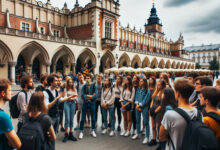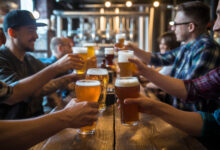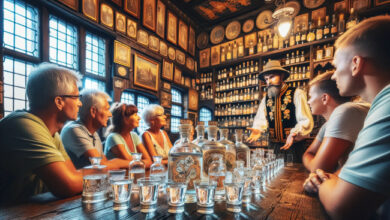Traditional Polish Food Tour
Discover the Flavors of Poland: A Guide to Traditional Polish Cuisine on a Food Tour
Embarking on a culinary journey through Poland offers you a taste of a rich cultural tapestry, reflected vividly in its traditional foods. Polish cuisine, with its hearty and diverse character, invites you to explore a gastronomic heritage shaped by the country’s history and geography.
From bustling street markets to family-run eateries, every dish tells a story of Poland’s past and its people’s deep connection to the land and seasons. As you traverse Poland, each region presents its own unique flavours and culinary traditions.
The experience isn’t simply about eating; it’s about immersing yourself in Polish culture, understanding the local customs, and savouring each bite with a new perspective on how this nation relates to its food.

You’ll find familiar comfort in dishes like pierogi, the country’s famed dumplings, and be intrigued by lesser-known delicacies such as gołąbki, which are cabbage leaves stuffed with a mix of minced meat and rice.
The Polish food scene embodies a community spirit where meals are meant to be shared, creating an opportunity for you to connect not just with Poland’s food but also with its people.
Whether sampling a smoky kielbasa sausage at a street vendor or tucking into a sumptuous kotlet schabowy at a traditional feast, your culinary tour is bound to be a journey of flavourful discovery and cultural enlightenment.
History of Polish Cuisine
Polish cuisine boasts a rich history shaped by various foreign influences and steeped in local traditions that have evolved over the centuries. Your exploration of this culinary heritage reveals a tapestry of tastes and techniques reflective of Poland’s past.
Influence of Other Cultures
Polish food has been influenced by the cultures of neighbouring countries and the nations that have historically occupied Polish lands.
The Lithuanian Union brought an influx of noble preferences into Polish cooking, introducing game dishes. Subsequent partitions of Poland by Russia, Prussia, and Austria saw the introduction of dishes such as borscht from Eastern influences and schnitzel from the West, each adapted into the national culinary repertoire.
Italian influences from the 16th century are evident in the use of vegetables like cabbage.

Traditional Dishes Through the Ages
Your appreciation of Polish traditional dishes would span from the hearty groats and game of the Middle Ages to the elaborate meals of the nobility and the simple, robust fare of the peasantry. Original Polish cuisine made heavy use of millet, rye, and wheat, alongside meats from wild and farm animals.
Over time, the introduction of potatoes and corn from the New World expanded the Polish diet. Meals were often seasoned with local herbs, spices, and a notable use of salt.

Traditional dishes that have endured through the ages include:
- Groats (Kasza): A staple of Polish meals for centuries.
- Pierogi: Dumplings filled with a variety of ingredients, such as cheese, potatoes, or fruit.
- Bigos: A hunter’s stew combining various meats with sauerkraut.
- Żurek: A sour rye soup typically served during Easter.
- Kotlet schabowy: A breaded pork cutlet akin to the Viennese schnitzel, enjoyed year-round.
Polish customs and traditions are often centred around these dishes, particularly during festive occasions like Christmas and Easter, where you’d encounter an array of these delicacies crafted with careful attention to tradition.
Essential Polish Dishes
When exploring Poland’s culinary traditions, you will encounter a variety of hearty soups, flavourful main courses, and sweet desserts that are central to the nation’s gastronomy.
Soups

Your introduction to Polish cuisine should start with soups, which are integral to any Polish meal. Two notable ones are:
- Barszcz Czerwony: A beetroot soup that can be served clear or with added ingredients like dumplings.
- Żurek: This sour rye soup often contains sausage or hard-boiled eggs, and is a unique taste of Poland.
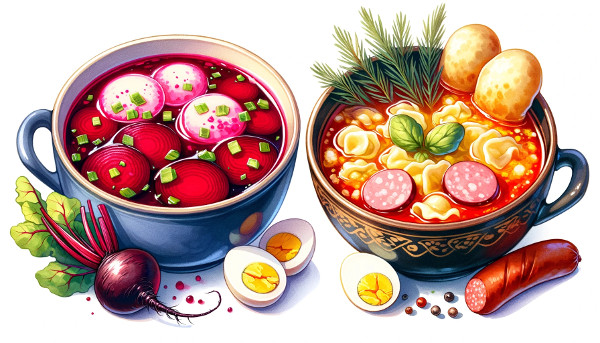
Main Courses
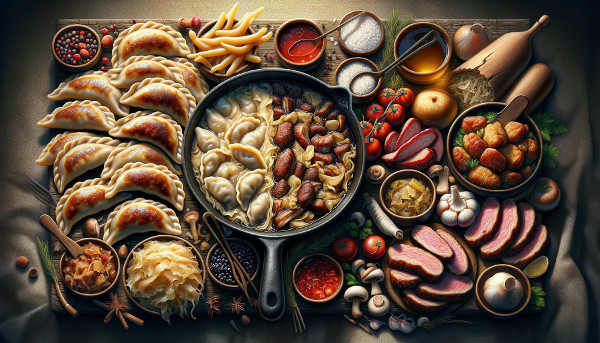
As you delve into the main courses, you will discover dishes that have been enjoyed for generations:
- Pierogi: These are Polish dumplings, stuffed with a variety of fillings ranging from meat, cheese, to fruits for a sweet option, and are a must-try.
- Bigos: Often referred to as ‘Hunter’s Stew’, it’s a mix of sauerkraut, various meats, and forest mushrooms, embodying the essence of Polish comfort food.
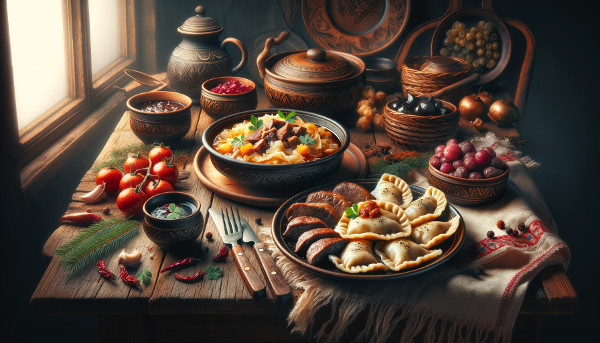
Desserts
Polish desserts are both delightful and diverse, often comprising pastries and dough-based treats:
- Sernik: A rich, dense cheesecake that’s a traditional sweet ending to a Polish meal.
- Makowiec: A poppy seed roll that’s staple during festive seasons and is enjoyed with a cup of tea or coffee.

Popular Polish Drinks
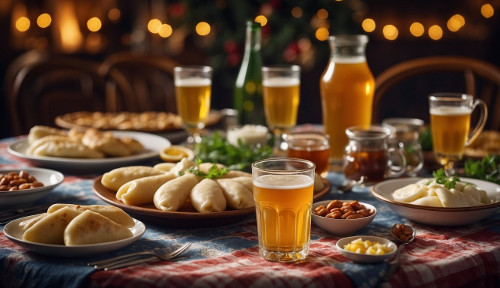 When touring Poland, your culinary journey should include the rich variety of traditional Polish drinks. From hearty alcoholic beverages to unique soft drinks, you will find an array of flavours that are deeply rooted in the country’s culture.
When touring Poland, your culinary journey should include the rich variety of traditional Polish drinks. From hearty alcoholic beverages to unique soft drinks, you will find an array of flavours that are deeply rooted in the country’s culture.
Alcoholic Beverages
Beers in Poland:
- Tyskie: One of the most renowned Polish beers, perfect for a leisurely evening.
- Żywiec: A cherished brand with a crisp taste that you’re likely to encounter in various pubs.
- Warka Strong: A stronger option for those who appreciate a more potent beer.
- Perła Miodowa: A honey beer offering a sweet twist on the traditional brew.
- Lech: A popular choice known for its smoothness and widely available.
Polish Vodka:
- Clear Vodkas: Often served chilled and consumed in shots, they are a staple at celebrations.
- Flavoured Vodkas: Infused with fruits or herbs, they are enjoyable neat or as part of cocktails.

Non-Alcoholic Beverages
Kvass (Kwas Chlebowy):
- A traditional soft drink made from fermented rye bread with a unique taste. It’s low in alcohol, historically enjoyed daily.
Tea and Coffee:
- Tea: Usually served black, though you may also find herbal varieties.
- Coffee: Poles enjoy their coffee strong and often black, though milk-based coffee drinks are also popular.
Compote (Kompot):
- A sweet beverage made from boiled fruits, typically served cold. A common accompaniment to meals and available in various fruit flavours.
Be sure to savour these drinks to experience an integral part of Polish dining culture.
Regional Variations of Polish Food
Poland’s culinary landscape is as diverse as its terrain, ranging from the Tatra Mountains in the south to the Baltic Sea in the north. As you explore traditional Polish food, you’ll discover unique regional dishes influenced by both geography and local customs.
Mountain Region Delicacies
In the Tatra Mountains, the robust and hearty cuisine is designed to fuel the highlanders through cold winters. A must-try is Oscypek, a smoked cheese made from salted sheep’s milk, with a distinctive texture and taste.
Delight in dishes like Kwaśnica, a sour cabbage soup, often enjoyed before a main course of Moskole, potato pancakes served with a range of toppings.
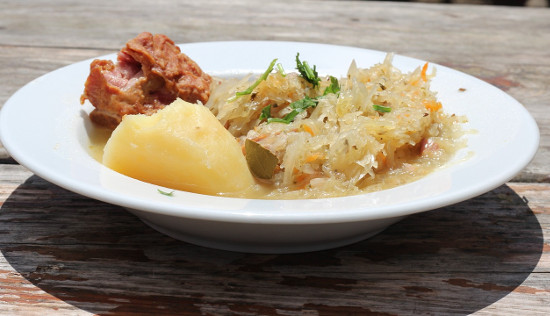
Seaside Specialties
Moving towards the Baltic Sea, you’ll encounter flavours shaped by the maritime climate. The coastal areas are renowned for their use of fresh fish. Śledź, or herring, is served in a variety of styles, from pickled to creamed.
In cities like Gdańsk, sample Zupa rybna, a hearty fish soup that encapsulates the essence of seaside living.
Urban Flavours
In urban centres like Wrocław and Krakow, the melting pot of cultures translates to a vibrant food scene with some Polish dishes taking on contemporary twists. Krakow’s beloved Obwarzanek Krakowski, a chewy bread ring that’s a cousin to the bagel, is an anytime snack turned cultural icon.
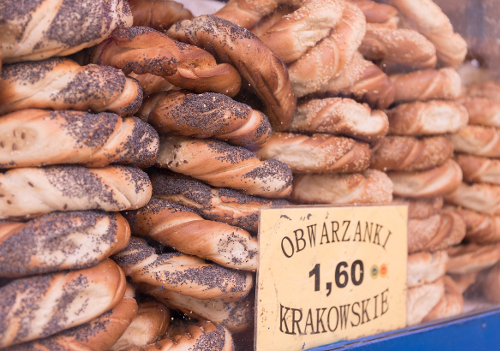
Wrocław, on the other hand, offers a taste of Pierogi with inventive fillings, showcasing the adaptability of this beloved Polish dish.
Food Tour Guide
Embarking on a traditional Polish food tour offers an immersive experience into the culinary culture of Kraków. Expert guides lead you through a range of tastings, pairing the city’s historical insights with its gastronomic delights.
Planning Your Tour
Before setting out, pinpoint the type of food tour that suits your interests. Factor in the duration, start times, and whether you prefer private or group tours.
Most tours offer free cancellation up to a day in advance, enabling flexibility. Tours frequently begin around 2 pm, but check for availability to suit your itinerary.
- Duration: Typically 3 to 3.5 hours
- Start Times: Often 2 pm, varies by tour
- Cancellation Policy: Usually free up to 24 hours before
Types of Food Tours
You have several options when it comes to the format of your tour:
- Walking Tour: Engage in a leisurely stroll through Kraków’s Old Town Market Square and the historic Kazimierz district.
- Street Food Tour: Discover Kraków’s vibrant street food scene with an array of snacks.
- Food Tasting Tour: Indulge in a variety of traditional Polish dishes, with around 13–14 food samplings.
Each tour type offers a unique perspective on Kraków’s culinary culture.
What to Expect
On your food tour, you will:
- Sample a selection of traditional Polish foods, which may include items from street vendors to family-run restaurants.
- Learn about the local cuisine from your guide, who will provide context and history for the dishes you taste.
- Experience a comprehensive dining experience, from appetisers to desserts, often including tastings of vodka and craft beer.
Note: Specific food offerings and tour itineraries can vary, so it’s best to confirm with your tour provider for the latest information.
Experiencing Polish Cuisine
Polish cuisine offers a rich tapestry of tastes stemming from its diverse historical influences and seasonal variety. When you embark on a traditional Polish food tour, immerse yourself in the local customs and partake in festivals celebrating the nation’s culinary heritage.
Etiquette and Dining Customs
In Poland, meals are an opportunity for sharing and hospitality. Tradition holds great importance, and it starts with the customary welcome with bread and salt, symbolising the host’s hospitality.
When you join a Polish feast, be prepared for multiple courses, including a starter, soup, main course, and dessert. Meal times are typically observed with punctuality, and it’s polite to accept the offerings from your host with gratitude.
Typical Meal Structure:
- Starter: Often cold appetisers like herring in oil or oscypek cheese with cranberries.
- Soup Course: A beloved staple such as barszcz (beetroot soup) or zurek (sour rye soup).
- Main Course: Can include traditional dishes like kotlet schabowy (breaded pork cutlet) or pierogi (stuffed dumplings).
- Dessert: Sweets such as szarlotka (apple cake) often grace the table.

Indulging in a meal also comes with a taste of local spirits, such as the renowned Polish vodka or cherry brandy, which are customary accompaniments to feast on special occasions. Drinking etiquette involves toasting together and is a significant part of the societal fabric.
Local Food Festivals
Food festivals in Poland are a vibrant expression of its culinary culture. They’re the perfect venue to experience the traditional flavours and learn about Polish fare.
Each region has its own festivals, often timed with the harvest of local produce, where you can witness the preparation of regional dishes.
Notable Festivals:
- Pierogi Festival in Krakow: Dedication to Poland’s iconic dumpling with myriad stuffings.
- Big Feast (Wianki): Boasts large arrays of Polish dishes while celebrating horticultural traditions.
Attending these festivals allows you to mingle with locals and savour authentic dishes while learning about Polish culinary traditions. Whether you’re sampling street food or sitting down for a full-fledged Polish meal, food tours can guide you to the heart of Poland’s food scene.
Notable Food Destinations in Poland
Explore the culinary landscapes of Poland across its celebrated cities. You’ll encounter the rich tapestry of Polish cuisine, from the bustling market squares to quaint patisseries.
Each city offers a distinct flavour of the nation’s heritage through its local delicacies and traditional dishes.
Warsaw’s Culinary Scene
As you navigate through Warsaw Old Town, you’ll experience a melding of history and modern gastronomy. Venture into the heart of the city, where Polish food takes centre stage in chic eateries and traditional restaurants.
Local favourites like pierogi and bigos are a must-try, and you can delve into these authentic flavours in the many establishments spread across the district.
Noteworthy Venues:
- Old Town Market Place: For a blend of historical ambiance and gourmet Polish cuisine.
- Hala Koszyki: This revitalised market hall is your go-to for a variety of culinary delights from modern Polish dishes to international fusion.
Krakow’s Vibrant Markets
Experience Krakow’s Market Square, the pulsing heart of the city’s food scene. The Rynek Główny, as it’s known in Polish, is surrounded by historical buildings that have stood watch over the plaza for centuries.
Krakow’s markets are rife with artisanal bread, cheeses, and smoked meats, giving you a true taste of the region’s culinary heritage. Check also Where to Eat in Krakow
Signature Experiences:
- Kazimierz District: Once a historical Jewish quarter, now a thriving spot for culinary exploration.
- Cloth Hall Markets: Immerse yourself in a banquet of local produce and traditional Polish gifts.
Wroclaw’s Patisseries

For those with a sweet tooth, Wroclaw’s patisseries are a treasure trove of confectionery wonders. In these aromatic bakeries, sample an array of Polish pastries, from the indulgent pączki to the subtle sweetness of sękacz. Each confection is crafted with care, honouring the recipes passed down through generations.
Patisserie Hotspots:
- Stare Jatki: This charming street is lined with small boutiques and eateries, perfect for tasting the sweeter side of Polish cuisine.
- Ostrów Tumski: Known as the ‘Cathedral Island’, it’s not only a site of historical significance but also a locale for decadent dessert spots.
Booking Your Polish Food Tour
When organising your culinary expedition to explore traditional Polish cuisine, there are key factors you need to consider, such as selecting the correct experience for your interests and budget, and ensuring you get value for money.
Selecting the Right Tour
Duration and Organisation: The length of the available tours varies, generally ranging from a couple of hours to a full day. When choosing, consider how much time you want to devote to the experience.
Most tours offer a live professional guide and a well-planned itinerary that includes various eateries, and, depending on the package, might also take you to landmarks like the Royal Castle.
Activities and Professional Guide: Look for tours that feature a live tour guide, ensuring a more authentic and informative experience.
Guides often share insights not just about the food but also about the local culture and history. Checking platforms like TripAdvisor or GetYourGuide can provide reviews on the tour’s organization and the quality of the guide.
Pricing and Value for Money
Sort and Value: Evaluate your options by comparing what’s included in the price. Some tours may include transportation, food, drinks, and even lodging in your package.
Start Planning Your Krakow Trip Now!
- Unsure where to stay in Krakow? Discover top-rated Old Town and Kazimierz hotels with Booking.com. Reserve now, pay later, and enjoy free cancellations.
- Book your airport transfer now and enjoy a hassle-free ride directly to your hotel. Driver will meet you at John Paul II International Airport Kraków–Balice.
- Take a Sobering Tour of Auschwitz. Arrange a visit to the Auschwitz-Birkenau Memorial and Museum to pay tribute and learn about this significant historical site.
⏰ Due to high demand, it’s strongly recommended to book your tickets, tour to Auschwitz and accomodation well in advance to secure your preferred dates and times! 🔖
- Explore the Fascinating Wieliczka Salt Mine! Book your guided tour today and discover this UNESCO World Heritage site just outside Krakow. These tours are popular year-round, so book early to avoid disappointment and ensure your spot.
- Looking for ideas? Check out our KrakowTOP.org recommended itineraries, including the famous Christmas Market, holiday events, and must-see Krakow attractions like Wawel Castle, Oskar Schindler’s Factory and St. Mary’s Basilica.
Ensure that the tour you select sorts these services clearly and provides a value for money experience that aligns with your budget.
Likely to Sell Out: Popular tours can sell out quickly, so it’s prudent to book in advance, especially if your chosen tour offers limited spaces for a more intimate, personalised experience.
Remember to look for features such as free cancellation and skip-the-line access, which can add significant convenience and flexibility to your tour experience.

